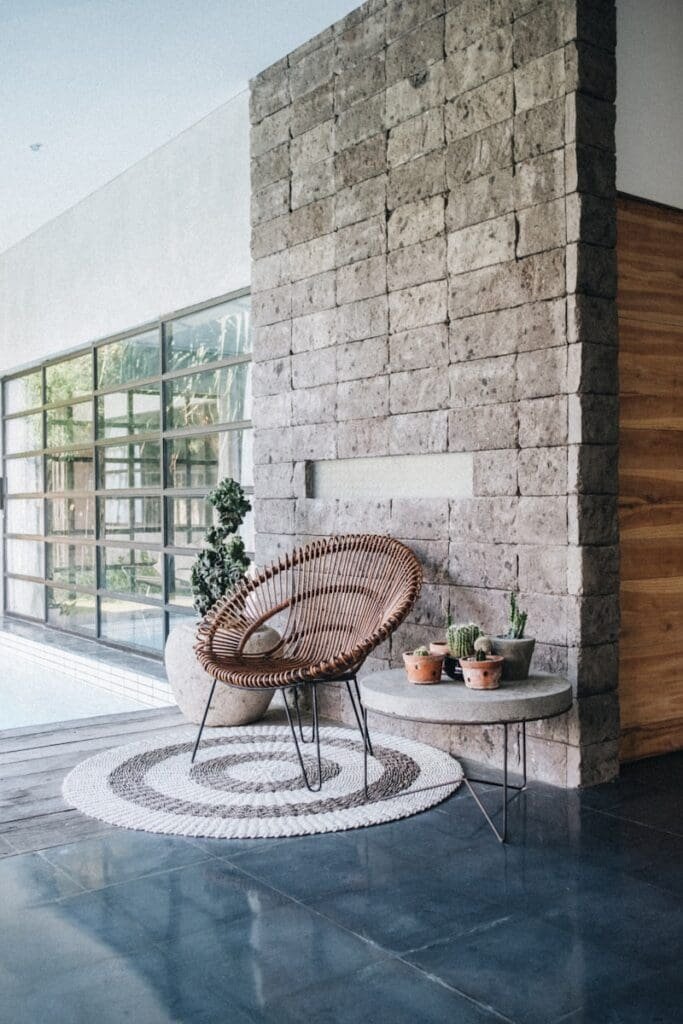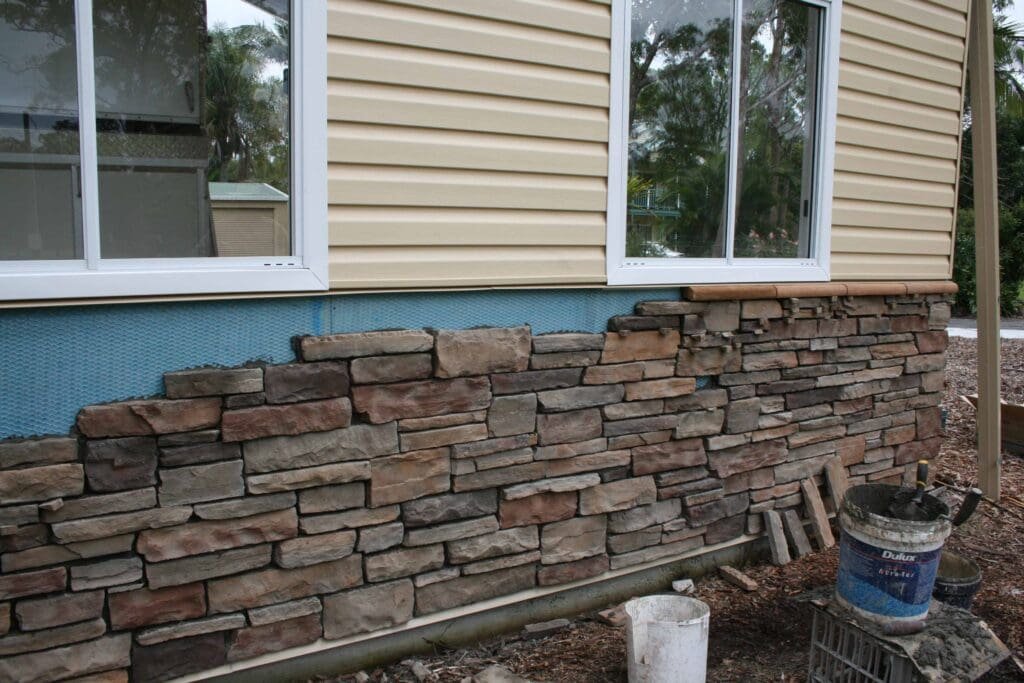Understanding Stone Veneer: A Complete Guide
Ever found yourself admiring a building or a fireplace and wondering, “Is that stone exterior real or not?”
More than likely, what caught your eye was the elegant use of stone veneer.
But what exactly is stone veneer?
If you’re considering using stone veneer for your next construction project or simply want to learn more about it, you’re on the right page.
Stone veneer is used to imitate the look of natural stone, and it has become increasingly popular as a construction and decorative material. The range of styles and its lighter weight compared to natural stone make it a versatile and convenient choice for various applications.
In this comprehensive guide, we’ll cover the intricacies of stone veneer. Starting from the basic definition and moving on to the different types, installation methods, applications, benefits, and even some common brands known for high-quality stone veneer products.
We’ll then discuss how to install stone veneer, the difficulty level involved, and also highlight the lifespan of stone veneers.
By the end of this post, you’ll be equipped with all the information you need to choose and utilize stone veneer effectively.
So, let’s get started, shall we?
Table of Contents
Explaining Stone Veneer in Construction

Introduction to Stone Veneer
Stone veneer is a popular construction material used to give buildings an aesthetic that mimics natural stone. It’s typically much lighter and easier to install than full stonework.
Types of Stone Veneer
Natural Stone Veneer
- Made from real stone
- Cut to a consistent thickness
- Offers a more authentic look
Manufactured Stone Veneer
- Made from concrete and other materials
- Designed to look like natural stone
- Lighter and often less expensive
Installation Methods
Mortar Method
- Stone veneer is adhered using a mortar mix
- Requires a scratch coat and a moisture barrier
Screw-in Method
- Uses screws and metal lath for installation
- Less common but faster to install
Applications of Stone Veneer
Stone veneer can be used for various applications in both residential and commercial buildings.
- Fireplace surrounds
- Exterior facades
- Interior accent walls
- Outdoor kitchens
Benefits of Stone Veneer
| Feature | Benefit |
|---|---|
| Lightweight | Easier to handle and faster to install |
| Cost-effective | Generally less expensive than natural stone |
| Durable | Resistant to weather and wear |
Conclusion
Stone veneer is a practical, versatile, and attractive option for adding the look of natural stone to various parts of a building. From fire pits to exterior walls, its applications are broad, and the benefits make it a favorite among builders.
How is Stone Veneer Attached?

Preparation for Installation
Before attaching stone veneer, it’s important to prepare the surface and gather the necessary materials.
- Surface Cleaning: Ensure the surface is clean, dry, and free of any debris or loose particles. Any contaminants can affect the adhesion of the veneer.
- Structural Support: Verify that the substrate is structurally sound and has sufficient load-bearing capacity for the stone veneer.
- Moisture Barrier: Install a moisture barrier to prevent water from penetrating the structure, which is especially important for exterior applications.
- Metal Lath Installation: For certain methods, a galvanized metal lath is attached to the wall to provide a base for the mortar to grab onto.
Adhesion Methods
There are various methods to attach stone veneer, each suitable for specific types of walls and applications.
Mortar Method
The mortar method is the most common approach for both natural and manufactured stone veneer.
- Scratch Coat Application: Apply a layer of mortar (scratch coat) over the metal lath and allow it to dry. This layer serves as a rough surface for the veneer to adhere to.
- Mortar Application: Spread a layer of mortar on the back of each stone and on the prepared wall surface.
- Setting the Stones: Press the stones firmly into the mortar bed, starting from the bottom and working upward. Use spacers if needed to ensure even spacing.
- Grouting: Once the stones are set, fill the gaps between them with grout using a grout bag or pointing tool. Make sure to clean off any excess grout.
Panelized Systems
Panelized systems are a newer method that can significantly reduce installation time.
- Pre-fabricated Panels: These panels come with stone already mounted on a backing, often making the installation quicker and easier.
- Attachment to Wall: Attach these panels to the wall using mechanical fasteners or adhesive, depending on the manufacturer’s instructions.
- Seaming: Align and fit the panels together to create a seamless look. Some systems have interlocking edges to ensure a tight fit.
Common Tools and Materials
Using the right tools and materials can streamline the installation process.
- Trowels: For spreading and applying mortar.
- Grout Bags: For applying grout between stones.
- Mortar Mixer: To mix mortar to the correct consistency.
- Level: To ensure stones are level and evenly spaced.
- Chisels and Hammers: To shape stones and adjust fits.
Ensuring Durability and Maintenance
Proper installation is key to the durability of stone veneer. Here are a few tips:
- Regular Inspection: Periodically inspect the veneer for any signs of damage or loosening.
- Repointing: If grout starts to crack or fall out, repointing may be necessary to maintain the structure’s integrity.
- Cleaning: Clean the surface with a soft brush and mild detergent. Avoid using harsh chemicals or pressure washing, which can damage the veneer.
Is Stone Veneer Hard to Install?

Factors Influencing Installation Difficulty
Installing stone veneer can range from an easy DIY project to a job best left for professionals, depending on various factors.
- Experience Level: If you have experience with masonry work or home improvement projects, you may find stone veneer fairly straightforward to install. For beginners, however, it may require a bit more learning and practice.
- Type of Stone Veneer: Natural stone veneer tends to be more challenging to work with due to its weight and irregular shapes, whereas manufactured stone veneer is lighter and often comes in more uniform shapes, making it easier to handle.
- Surface Preparation: Properly prepping the surface can be time-consuming and detailed. Ensuring structural soundness, cleaning the substrate, and installing a moisture barrier are all important steps.
- Installation Method: Choosing between mortar and panelized systems can significantly impact the difficulty. Mortar requires mixing and skill in applying even layers, while panelized systems can be quicker and easier but may need precise alignment.
Safety Considerations
It’s important to keep safety in mind during the installation of stone veneer.
- Protective Gear: Wear gloves, safety glasses, and a dust mask to protect yourself from debris and dust.
- Carrying Heavy Materials: Stone veneer can be heavy. Use proper lifting techniques or enlist help to avoid injury.
- Tool Safety: Be careful when using tools like chisels, hammers, and mortar mixers to avoid accidents.
Common Mistakes and How to Avoid Them
Avoiding common mistakes can make the installation process smoother and the end result more satisfactory.
- Skipping Surface Prep: Neglecting to clean and prime the surface can result in poor adhesion and future issues with the veneer. Always ensure the surface is ready.
- Inconsistent Mortar Application: Uneven mortar layers can lead to loose stones or an uneven appearance. Take your time to apply mortar consistently across the surface and the back of each stone.
- Improper Grouting: Not filling gaps properly or allowing grout to set on the surface can result in a messy finish. Use a grout bag for precision and clean as you go.
- Ignoring Manufacturer Instructions: Every product can have specific requirements. Always read and follow the manufacturer’s installation guidelines to avoid voiding any warranties.
When to Hire a Professional
If the prospect of installing stone veneer on your own feels overwhelming, consider hiring a professional.
- Complex Projects: For intricate designs or large-scale installations, professional skills can ensure a flawless finish.
- Structural Concerns: If the installation involves load-bearing walls or structural elements, expert advice can avert potential issues.
- Time Constraints: If you need the project completed quickly, a professional team can speed up the process without compromising quality.
How Long Do Stone Veneers Last?
Longevity of Natural Stone Veneer
Natural stone veneer is known for its exceptional durability and long-lasting appearance. Here are some key points:
- Material Integrity: Natural stone is inherently durable and resistant to damage from environmental factors such as UV radiation, water, and temperature changes.
- Lifespan: When installed correctly, natural stone veneer can easily last for decades, often over 50 years, without significant degradation.
- Maintenance: Requires minimal maintenance. Occasional cleaning and periodic inspections to address any potential issues, such as mortar erosion, can extend its lifespan further.
Longevity of Manufactured Stone Veneer
Manufactured stone veneer, while not as long-lasting as natural stone, still offers considerable durability:
- Material Composition: Made from Portland cement, lightweight aggregates, and iron oxide pigments, these materials are designed to mimic natural stone and offer durability.
- Lifespan: With proper installation and maintenance, manufactured stone veneer can last 20-30 years. However, exposure to extreme weather conditions can affect its longevity.
- Maintenance: Requires regular maintenance, including inspection for cracks and chips, as well as occasional sealing to protect against moisture and stains.
Factors Affecting Longevity
Several factors can influence the lifespan of both natural and manufactured stone veneer:
- Installation Quality: Proper installation is vital. Improper installation can lead to water infiltration, which can degrade both the veneer and the underlying structure.
- Climate Conditions: Extreme weather conditions, such as heavy rainfall, freezing and thawing cycles, and intense sunlight, can shorten the lifespan of stone veneers.
- Maintenance Practices: Regular maintenance, including cleaning, sealing (for certain types), and timely repairs, can significantly extend the lifespan of stone veneers.
Comparing Lifespans: Natural vs. Manufactured
To provide a clear comparison, consider the following table:
| Type of Stone Veneer | Typical Lifespan (Years) |
|---|---|
| Natural Stone Veneer | 50+ Years |
| Manufactured Stone Veneer | 20-30 Years |
Natural stone veneer is typically the longer-lasting option, making it an excellent investment for projects where longevity is a priority. However, manufactured stone veneer offers a cost-effective alternative with a respectable lifespan, suitable for a variety of applications.
Wrapping Up Stone Veneer
In summary, stone veneer, whether natural or manufactured, presents a versatile, sleek, and lasting solution for revamping your residential or commercial building. These veneers offer the charm of authentic stone without the drawbacks, and with the variety in types, applications, and installation methods, there’s likely a stone veneer suitable for your project.
The key to longevity lies in the right preparation for installation, proper adhesion methods, and regular maintenance. Whether you’re a DIY enthusiast or prefer professional services, stone veneer installation can transform your space, adding a touch of elegance and sustainability.
Frequently Asked Questions – FAQs
What is stone veneer?
Stone veneer is a lightweight construction material that mimics the aesthetic of natural stone and is easier to install.
What are the different types of stone veneer?
There are two main types: natural stone veneer made from real stone and manufactured stone veneer made from concrete and other materials.
How is stone veneer installed?
Stone veneer can be installed using the mortar method or the screw-in method, depending on the type of veneer and the surface it’s being applied to.
What are some uses of stone veneer?
Stone veneer can be used for various applications like fireplace surrounds, exterior facades, interior accent walls, and outdoor kitchens.
Is stone veneer expensive?
While cost can vary based on the brand and type of stone veneer, it’s generally less expensive than full natural stone while offering comparable aesthetics.






